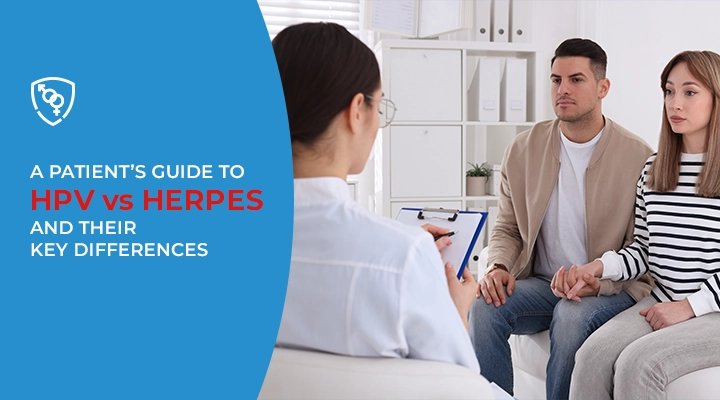Many people search online, wondering, Are HPV and herpes the same thing? or, How do I know which one I have? It’s understandable; these infections can sound similar, and both are very common. But HPV vs herpes are not the same. They involve different viruses, symptoms, risks, and testing methods.
At Manhattan STD Testing, we understand the confusion surrounding these infections, and this guide breaks down the difference between HPV and herpes so you can better understand your health and know when to get evaluated.
What Is HPV (Human Papillomavirus)?
HPV is a group of more than 100 related viruses. Some types cause genital warts, while others are considered high-risk because they can lead to cancers like cervical, anal, penile, and throat cancer.
How HPV Spreads
- Primarily through skin-to-skin sexual contact
- Can spread without symptoms or visible warts
- Can infect the genitals, anus, mouth, and throat
Key Facts About HPV
- Often has no symptoms
- Some strains cause genital warts
- High-risk strains can cause cancer
- Vaccines are available for prevention
What Is Herpes (Herpes Simplex Virus)?
Herpes is caused by HSV-1 or HSV-2. HSV-1 commonly affects the mouth (oral herpes), while HSV-2 more commonly affects the genitals, though both viruses can infect either area.
After infection, herpes stays in the body for life and may cause periodic outbreaks.
How Herpes Spreads
- Skin-to-skin contact
- Oral, vaginal, or anal sex
- Can spread even without visible sores
Key Facts About Herpes
- Causes painful blisters or sores
- May cause tingling or burning before outbreaks
- Outbreaks can recur
- Antivirals help manage symptoms
HPV vs Herpes: Key Differences
| Feature | HPV | Herpes |
| Virus Type | Human Papillomavirus | Herpes Simplex Virus (HSV-1, HSV-2) |
| Transmission | Skin-to-skin contact | Skin-to-skin contact or fluid exchange |
| Symptoms | Often none, can cause warts | Painful blisters or sores |
| Risk | Can lead to cancer | Causes recurrent outbreaks |
| Treatment | Vaccines available; warts removable | No cure; antiviral management |
Symptoms
HPV Symptoms:
- Often no visible signs
- Soft, raised, painless genital warts
Herpes Symptoms:
- Painful blisters or sores
- Itching, tingling, or burning sensations
- Flu-like symptoms during first outbreak
Because symptoms can vary, HPV can be mistaken for herpes, and vice versa, another reason professional evaluation is important.
Transmission and Risk Factors
Both HPV and herpes spread through skin-to-skin sexual contact, even when symptoms aren’t visible.
Risk increases with:
- Multiple sexual partners
- Unprotected sex
- A partner who has an active infection
- Weakened immune system
Diagnosis and Testing
- Pap smear (cervical screening)
- HPV DNA testing
- Visual exam for genital warts
- Swab test from sores
- Blood test for HSV antibodies
Self-diagnosis is often unreliable. Testing provides clarity and peace of mind.
Treatment Options
HPV Treatment:
- Many infections clear naturally
- Genital warts can be treated or removed
- HPV vaccine prevents most high-risk strains
Herpes Treatment:
- No cure, but antivirals reduce outbreaks
- Daily suppressive therapy lowers transmission risk
Which Is Worse HPV or Herpes?
Neither infection is universally worse. They affect patients differently:
- HPV can increase cancer risk but is often silent
- Herpes causes painful outbreaks and emotional stress, but does not cause cancer
The best approach is early testing, proper management, and open communication with partners.
Prevention and Safe Practices
- Get the HPV vaccine if eligible
- Use condoms and dental dams
- Avoid sexual contact during outbreaks
- Regular STD screening
- Discuss STI history with partners
When To See A Doctor
Seek evaluation if you have:
- Persistent sores or blisters
- Unusual bumps or growths
- Genital itching or discomfort
- Concerns after unprotected sex
Regular sexual health checkups help detect issues early and support long-term wellbeing. For broader screening needs, explore our comprehensive STD panel.
Conclusion
HPV and herpes are two of the most common STIs, and while they share similarities, they differ in causes, symptoms, risks, and treatment. Both are manageable with the right care.
If you’re worried about your symptoms or possible exposure, Manhattan STD Testing provides confidential, accurate testing so you can know your status and get proper treatment.
Frequently Asked Questions
Can someone have HPV or herpes even if they’ve only had one partner?
Yes. Both viruses can be transmitted from a single sexual encounter, even if the partner has no symptoms.
Does either virus affect fertility?
Herpes does not impact fertility, while HPV rarely affects fertility directly. However, complications from advanced cervical changes (if untreated) may influence reproductive health.
Do HPV or herpes always show up on routine STD tests?
No. HPV and herpes require specific testing. Not all standard STD panels include them unless requested.
Can lifestyle factors influence outbreaks or infection risk?
Yes. Stress, lack of sleep, and immune suppression may trigger herpes outbreaks and increase overall vulnerability to infections.
Are HPV and herpes only spread through penetrative sex?
No. Both viruses can spread through intimate skin-to-skin contact, including oral sex and close genital contact without penetration.
Disclaimer
This blog is for informational & educational purposes only and does not intend to substitute any professional medical advice or consultation. For any health-related concerns, please consult with your physician, or call 911.

-
About The Author
Dr. Syra Hanif M.D.Board Certified Primary Care Physician
Dr. Syra Hanif is a board-certified Primary Care Physician (PCP) dedicated to providing compassionate, patient-centered healthcare.


